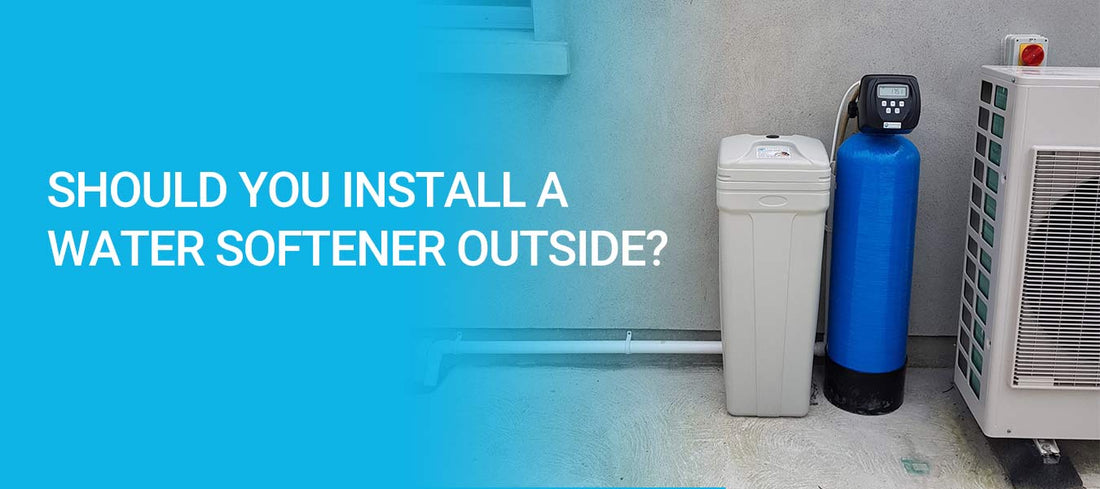Buying a
water softener for your home is an investment that will make your life easier by preventing nuisances caused by hard water. It will
remove limescale buildup in the house, extend the lifespan of your appliances, and save you money. One of the important decisions homeowners have to make is
where to get a water softener installed? Should it go under your kitchen sink, utility room, or garage? In some instances, there might not be enough space under the kitchen sink making the installation more challenging. This presents a question: “Can I install a water softener outside my house?” Well, the answer is simple. Yes, you can.
Why Should You Choose Outside Installation for water softener?
Let’s agree to this: a water softener could take up a lot of space under the kitchen sink. And this is what prompts homeowners to go for outside installation and save valuable cupboard space. On the other hand, there may not be enough space under the kitchen sink to fit a water softener in the first place. In such cases, outside installation is usually preferred. And lastly, in some instances, there may not be an internal mains water shut off valve. All water softeners need to be located near the entry point of your home’s water supply. This is often close to the water meter if you are supplied with a public water supply (Irish Water).
Considerations for Outside Installations
The perfect location for a water softener is somewhere flat, level, accessible, and near the point of entry of the house’s water supply. When installing a water softener outside of your home, just be sure to keep the following factors in mind:
1. Temperature
A water softener’s resin tank is typically made of fibreglass which is not a very good insulator against cold temperatures. A water softener that is exposed to freezing temperatures can freeze in a very short period of time especially if compounded by wind or freezing rain. A frozen media tank could lead to the fibreglass shell cracking or internal damage to the distribution tube, a thick plastic tube that runs through the centre of the media tank that supplies the tank with water. This could result in the resin beads inside the tank escaping into your home’s plumbing, potentially causing damage to the rest of your home.
2. Sunlight
Sunlight is another element to consider before installing your water softener outdoors. Sunlight as a whole should not damage a water softeners tank or its parts, but the ultraviolet rays from the sunlight can over time cause the structure of the fibreglass resin to deteriorate and weaken. The same can happen to the plastic or other composite materials used in the water softeners’ control valve if they are exposed to sunlight over a period of time.
3. Accessibility
A water softener should always be installed in a convenient and assessable place. Keep in mind, you’ll need to regularly add softener salt to the brine tank and you will need some extra space for storing the extra salt bags that you will need for the water softener. You don’t want to have to be lugging those bags from the other end of the property.
4. Availability of Drain & Power Source
A drain must be readily available to facilitate easy disposal of the brine solution after backwash. Backwash or regeneration is the process that washes the resin beads with a highly concentrated brine solution. Since the beads act as a sponge and absorb the hardness minerals from your water, they eventually get “full” and need to be cleaned. After regeneration, the resin can soften water again.
Protect Your Softener with an Insulated Cover
The combination of sun, wind and rain is not conducive to the longevity of water softener. To prevent a water softener from freezing in winters, it is best to keep it protected inside an insulated cover. Outdoor water softener enclosures are designed to protect your system. Some enclosures are insulated, whereas others are not. They are all waterproof, though. If you want to buy an outdoor enclosure, options vary from plastic to metal cabinets. Alternatively, you can build it yourself. If you’re considering purchasing a cover or an enclosure for your household water softener, make sure to factor in the additional costs of doing so.
Choose Professional Installation
A water softener is usually installed inside the house and most manufacturers do not recommend installing their products outside. However, for any reason, if an indoor installation is not possible, installing a water softener outside your home is possible with certain precautions. Professional installers at Celtic Water Solutions have dealt with several ways to properly and safely set up and install water softeners, depending on the unique requirements of the homeowner. We always follow a consultative approach to our sales and recommend the best solution counting on our wealth of experience. If you are looking to buy a
water softener for your home, feel free to get in touch with our sales team.
Request a Call

